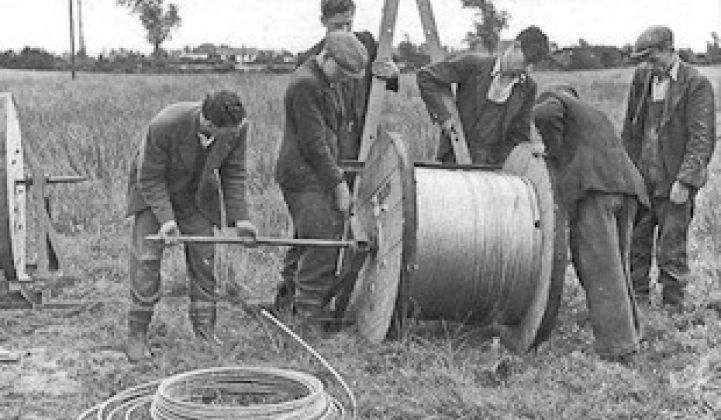Every four years, a group representing America's civil engineers grades the health of U.S. infrastructure. And every single time since 1998, the grades have been nearly failing.
The latest report card from the American Society of Civil Engineers (ASCE) comes after the government spent hundreds of billions of dollars through the stimulus package to improve the country's roads, rails, and bridges. The outcome is only a marginal improvement, with the overall grade moving from a D to a D+.
"While the modest progress is encouraging, it is clear that we have a significant backlog of overdue maintenance across our infrastructure systems, a pressing need for modernization, and an immense opportunity to create reliable, long-term funding sources to avoid wiping out our recent gains," writes ASCE.
So how did cleantech-related sectors fair? Some better than others. There were eight categories in the ASCE report card that apply to energy or cleantech. Although the organization doesn't specifically mention clean technologies as solutions, it does call for "new, more efficient methods and materials for building and maintaining the nation’s infrastructure" to make infrastructure projects more environmentally sound.
Energy: D+
A lot has changed in the energy sector over the last four years. America is producing more fossil fuels than at any time since the early 1990s, natural gas is pushing coal generation down, and renewable electricity has doubled since Obama took office. However, ASCE still gives America a D+, saying it has under-invested in transmission lines, pipelines, and other energy reliability projects. This grade is unchanged from the last report card four years ago.
According to ASCE, America will see an investment gap in distribution infrastructure of $57 billion by 2020. On the transmission side, the investment gap could total $37 billion. While the organization is clearly bullish about a centralized energy system reliant on transmission projects and pipelines, it also praises recent public and private investments in distributed smart grid technologies as a way to revitalize America's aging electric grid.
Dams: D
According to ASCE, the average age of the 84,000 dams around the country is 52 years. In 2012, there were nearly 14,000 "high-hazard" dams spread throughout the country. The declining health of U.S. dams represents a major opportunity for hydro producers. ASCE estimates that $21 billion is needed to repair high-risk dams. Since only 3 percent of the nation's dams are used for hydroelectric projects, these investments could theoretically include hydro facilities where it makes sense.
Drinking Water: D
Compared to much of the world, the U.S. enjoys very high-quality drinking water. However, the infrastructure to maintain that quality is aging. The pipes and water mains are often a century old and are susceptible to leaks, ruptures and possible contamination. With nearly a quarter million water main breaks every year, this sector is ripe for companies with pipeline leak detection methods and other technologies to make better use of water infrastructure.
Wastewater: D
The country's wastewater infrastructure is also in need of a major upgrade. Over the next two decades, ASCE estimates America will need to invest nearly $300 billion to keep the pipes, sewers and wastewater treatment facilities functioning properly. This is another opportunity for companies monitoring pipeline infrastructure. And as municipalities start making investments in water treatment facilities, there's also a potential long-term opportunity to invest in technologies that generate energy from wastewater to cut down on electricity consumption.
Hazardous Waste: D
With funding for the EPA's Superfund cleanup program totaling $500 million less than requested levels, there are hundreds of thousands of hazardous waste sites waiting to be cleaned up. Because of the sluggish pace in cleanup, ASCE gives the U.S. a D in this area. This is yet another opportunity for renewable energy developers. With close access to transmission and other infrastructure, brownfields can offer attractive siting opportunities. The Environmental Protection Agency estimates there are nearly half a million brownfield sites around the U.S. that could host renewable energy projects.
Solid Waste: B-
Solid waste is an area where the U.S. is doing pretty well. According to ASCE, Americans have doubled the amount of material they recycle since 1980. Meanwhile, per capita waste generation has started to decline. But with many of America's landfills reaching capacity, there's still a lot of room to implement landfill gas projects, waste-to-biofuels projects, and other zero-landfill solutions.
Rail: C+
With the cost of driving increasing, more Americans are hopping on rail lines to commute. According to ASCE, Amtrak has doubled its ridership since 2000. And since the last report card came out in 2009, the rail industry has increased capital investments by $75 billion. The increase in spending and ridership gave the rail sector the biggest jump in grading. However, there are still major cost hurdles to rolling out the next generation of rail, as California has found out.
Public Transit: D
Although more people are riding public transportation and driving less, the ASCE grade for transit was still a D. This is because nearly half of U.S. households still don't have direct access to public transportation. According to ASCE, the decline in the health of America's transit system costs the economy $90 billion a year. Improving public transportation isn't just about building new metro and bus lines. It's also about putting out the apps and maps to make it more attractive for people to use them.
America still has a lot of work to do in maintaining its infrastructure. That's a major challenge. It's also a major opportunity for clean technologies.



